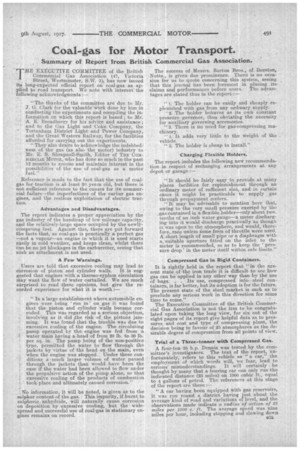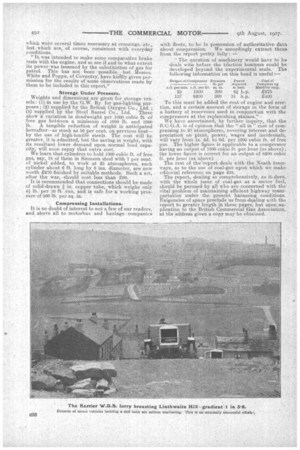Coal-gas for Motor Transport.
Page 7

Page 8

If you've noticed an error in this article please click here to report it so we can fix it.
Summary of Report from British Commercial Gas Association.
THE EXECUTIVE COMMITTEE of the British Commercial Gas Association (47, Victoria
Street, Westminster, S.W. has now issued its long-expected official report on coal-gas as applied to road transport. We note with interest the renewing. acknowledgments :— " The thanks of the committee are due to Mr. J. G. Clark for the valuable work done by him in • conducting the experiments and compiling the information on which this report is based ; to Mr.
• A. E. Broadberry for his advice and assistance ; and to the Gas Light and Coke Company, the Tottenham District Light and Power Company, and the Great Western Railway, for thefacilities afforded for carryina.b out the experiments. "They also desire to acknowledge the indebtedness of the gas (as also the motor) industry to Mr. E. S. Shrapnell-Srnith, Editor of THE COMMERCIAL MOTOR, who has done so much in the past 12 months to arouse and maintain interest-in the possibilities of the use of coal-gas as a motor
• . fuel." . • _ :Reference is made to the fact that the use of coalgas for traction is. at least 20 years Old, but there is not suffieient reference to the causes for its commercial failure--the imperfections of the earlier gas engines, and the restless exploitation of electric traction..
Advantages and Disadvantages.
The report indicates a proper appreciation by the gas industry of the handicap of low mileage capacity, and the relatively-large space occupied by the newlycompeting fuel. Against this, there are put forward the facts that, as coal-gas is practically a perfect gas —not a vapour—an engine in which it is used starts easily in cold weather, and keeps clean, whilst there can be no jet blockages in the carburetter, seeing that such an attachment is not used.
A Few Warnings.
Users are told that excessive cooling may lead to
corrosion of piston and cylinder walls. It is suggested that engines with a thermo-syphon circulation may want the flow of water curtailed. We are much surprised to read these opinions, but give the recorded experience for what it is worth :— "In a large establishment where automobile engines were being 'run in' on gas it was found that the piston and cylinder walls became corroded. This was regarded as a serious objection, involving as it did he risk of the pistons jamming. It was found that the trouble was due to excessive cooling of the engine. The circulating pump operated by the engine was fed from a water main having a head of from 20 lb. to 30 lb. per sq. in. The pump being of the non-positive type, permitted the water to -flow through the jackets by virtue of the head on the main, even when the engine was stopped. Uncles these conditions a much larger volume of water passed through the jackets than would have been the ease if the water had been allowed to flow under the propulsive action of the pump alone, so that excessive cooling of the products of combustion took place and ultimately caused corrosion."
No information, it will be noted, is given as to the milphur content of the gas. This impurity, if burnt to sulphuric anhydride, will naturally cause corrosion on deposition by excessive cooling, but the widespread and successful use of coal-gas in stationary engines remains on record. The success of Messrs. Barton Bros., of Beeston, Notts., is given due prominence. There is no occasion for us to quote concerning this system, seeing that this journal has been foremost in placing its claims and performances before users. The advantages are stated thus in the report :— "1. The holder can be easily and cheaply replenished with gas from any ordinary supply. '2, The holder behaves as its own constant pressure governor, thus obviating the necessity for auxiliary governing accessories. ".3There is no need for gas-compressing machinery. " t. It adds very little to the weight of the vehicle.
" 5. The holder is cheap to install."
Charging Flexible Holders.
The report includes the following new recommendation, in respect of recharging arrangements at any depot or garage :—
"It should he fairly easy to provide at many places facilities for. replenishment through an ordinary meter of sufficient size' and in certain cases it might be practicable to supply gas through prepayment meters. "It /nay be advisable to mention here Chat, owing to the very small pressure exerted by -the ,gas contained in a flexible holder-'-only about two tenths of an inch water gauge—a meter discharging into it would discharge practically as thougn it was open to the atmosphere, and would, therefore, race unless some form of throttle were used. A short length of small pipe or a diaphragm with a_ suitable aperture fitted on the inlet. to the meter is recommended, so as to keep the pressure drop' in the meter itself within safe limits."
Compressed Gas in Rigid Containers.
It is rightly held in the report that "in the present state of the iron trade it is difficult to see how gas can be applied in any other way than by the use of bags. . . Its use, compressed into steel containers, is far better, but its adoption is for the future. The present state of the steel market is such as to preclude any serious work in this direction for some time to come."
The Executive Committee of the British Commercial Gas Association is not the less to be congratulated upon taking the long view, for six out of the eight pages of its report give helpful data as to pressures and cost and type of compressing plant, the decision being in favour of 25 atmospheres as the desirable degree of compression from all points of view.
Trial of a Three-tonner with Compressed Gas.
A four-ton 35 hp. Dennis was tested by the committee's investigators. The text of the report, unfortunately, refers to this vehicle as "a car," the employment of which words will, we fear, lead to serious misunderstandings. It will certainly . be thought by many that a touring car can only run the indicated distance (25 miles) on 1000 cubic ft., equal to 4 gallons of petrol. The references at this stage of the report are these :-
"A car having been equipped With gas reservoirs, it was run round a district having just about the average kind of road and variaticins of level, and the observations made indicate a radius. of action, of 25 miles per 1000 c.ft. The average speed was nine miles per hour, including stopping and slowing down
which were several times necessary at crossings. etc., but which are, of course, consistent with everyday conditions.
"It, was intended to make some comparative brake tests with the engine, and so see if and to what extent its power was lessened by the substitution of gas for petrol. This has not been possible, but Messrs. White and Poppe, of Coventry, have kintly given permission for the results of some observations made by them to be included in this report," Storage Under Pressure.
Weights and dimensions are given for storage vessels: (1) in use by the G.W. Ry. for gas-lighting purposes; (2) supplied by the British Oxygen Co., Ltd. ; (3) supplied by the Steel Barrel Co., Ltd. These show d variation in deadweight per 1000 cubic ft.. of free gas betWeen a minimum of 1080 lb. and 1900 lb. A tangible reduction of weight is anticipated hereafter—as much as 50 per cent, on previous best— by the use of high-tengile steels. The cost will be greater, it is admitted, but the saving in weight, with its resultant lower demand upon normal load capacity, will soon repay that extra cost.
We learn that cylinders to hold 1000 cubic ft. of free gas, say, 18 of them in Siemens steel with 7 per cent. of nickel added, to work at 25 atmospheres, each cylinder about 6 ft. long by 8 ins, diameter, are now worth £270 finished by suitable methods. Such a set, after the war, should cost less than £90.
It is recommended that connections should be made of solid-drawn in. copper tube, which weighs only 411 lb. per 10 ft. run, and is safe for a working pressure of 500 lb, nes sq. in.
Compressing Installations.
It is no doubt of interest to not a few of our readers, and above all to motorbus and haulage companies with fleets, to be in possession of authoritative data about compression. We accordingly extract these from the report pretty fully : " The question of machinery would have to be dealt with before the traction business could be developed beyond the .experimental scale. The following information on this head is useful :—
Output of Compressor Pressure Power Cost of lb. per required Compress ng c.lt, per mm. e.f$, per hr. sq. In. at belt. Machine only.
25 1.500 300 6i h.p: £275 137 8200 300 34 h.p. £400 To this must be added the cost of engine and erection, and a certain amount of storage in the form of a battery of 'reservoirs used in conjunction with the compressors at the replenishing station." • We have ascertained, by further inquiry, that the B.O.G.A. is of opinion that the "all in" cost of cornpreSsing to 25 atmospheres, covering interest and depreciation on plant, power, wages and incidentals, will vary from is. 4d. to 9d. per 1000 cubic ft. Of free gas. The higher figure is applicable to a compressor having an output of 1500 cubic ft. per hour (as above); the lower figure is Correct for an output of 8200 cubic ft. per hour (as aboVe). The rest of the'report deals with the Neath tramways, as to the use of coal-gas upon which we make editorial reference on page 485. The report, dealing so comprehensively, as it' does, with the whole issue of coal-gas as a motor fuel, should be perused by all who are concerned with the vital problem of maintaining efficient highway transportation under the present harassing conditions. Exigencies of space preclude us from.dqaling with the report to greater length in these pages, but upon application to the British Commercial Gas Association, at the address given a copy may be obtained.






















